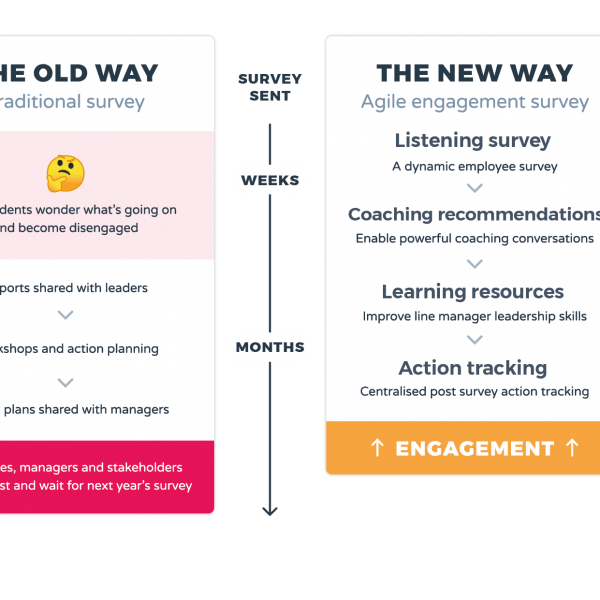This guide on employee wellbeing has been created in association with Access Group. Based on our collective experience and the data collected in our surveys, we have uncovered key insights on employee wellbeing, helping you take action and make a real difference.
A little introspection every now and then is necessary and positive, not just for each of us as individuals, but for businesses and organisations too. When times are hard or uncertain, both companies and individuals tend to focus hard on the obvious problem: the bottom line. The trouble is, when the bottom-line is firmly front of mind, senior managers and MDs often quickly lose interest in discussions about employee wellbeing. In fact, when the pressure is on to increase profits they rarely pay lip-service to new initiatives that don’t directly impact the bottom line.
Yet, it’s been proven many times that happier people and engaged employees are more productive. So, if it’s profit that gets attention, employee wellbeing should definitely be high on the business agenda.
We discuss the controversial and widely underestimated challenge of improving employee mental health and wellbeing. Exploring the true cost of ignoring the issue and providing you with tips and key strategies to help you make a positive change in your business.
Covid 19 update:
In these very challenging times, being able to support your team is crucial. The move to remote working on this scale is likely to be very new to you as an organisation. We have some resources that may be of help:
- How to look after your remote workers
- World Health Organization – mental health and psychosocial considerations during the COVID-19 outbreak
- CIPD factsheet
Contents
Gameplan 1: Build a business case for higher employee wellbeing
Gameplan 2: Listen to your employees
Gameplan 3: Create your wellbeing action plan
Wellbeing initiatives and strategies
Gameplan 1: Build a business case for employee well-being
Let’s kick off with a wider look at the issue of employee wellbeing and company culture. Getting you in the right headspace to take action, whether you are already sold on the importance of improving employee wellbeing or ready to be to be convinced.
The current state of employee health and wellbeing
We probably don’t need to tell you that there’s a long way to go when it comes to improving wellbeing in the workplace. While there has been some progress with changing attitudes, many businesses are still not quite sure what an employee programme looks like and how it truly impacts the wider business.
Most importantly, while Team Managers and HR Directors alike may be keen to make progress in workplace wellbeing, senior stakeholders are not so easy to convince.
Our mental wellbeing in the workplace survey found that 75% of HR professionals either have or are implementing a wellbeing strategy in the next 12 months. All very positive, until you see that only 30% are experiencing a successful adoption rate of that strategy.
So, the awareness of improving mental and physical wellbeing of staff is there, the intention is there, but the lack of backing from key stakeholders and lower ranking on the priority list is causing a problem.
What is wellbeing at work?
Many businesses think positive working environments are ones with free beers and company perks like pool tables and employee awards, yet they are still scratching their heads as to why they’re struggling with employee engagement and retention (see our post on how to motivate people without free beer!).
What’s left is still a reluctance from the top to accept the importance of nurturing company culture and improving employee wellbeing. It’s still way too low on the list of priorities and not enough businesses have a deep enough understanding on just how much it impacts those top goals and challenges for the year ahead.
Proving the value of an employee wellbeing strategy
To build the business case for employee wellbeing you first need to help senior stakeholders to understand the intrinsic link it has to those top goals. To help you do that here’s a quick breakdown of those links:
Employee engagement
Happier employees are more likely to feel a sense of belonging to their employer, have a sense of purpose and therefore engage with the business.
Growth & Scalability
As your company grows you need your people to be on board to help you manage and scale the survey around increasing demands. The last thing you need is a rise in staff turnover and increased recruitment costs. Longer term employees that are happy are also more likely to help build an overall thriving working culture as the business grows.
Recruitment / retention
If your employees are happy they are likely to stay for longer and fight harder to remain with the company, even when there are weaknesses along the way i.e. lack of pay rise, training and company perks. They are also likely to speak highly of your company as an employer and recommend friends. No doubt, new candidates touring the office will also pick up on a happier environment too.
If lifting the lid on this perspective isn’t enough, here are some impressive statistics and insights from employee wellbeing experts to help you make your point in that next boardroom meeting:
Increase in sales
In his book The Happiness Advantage, Shawn Achor makes the case that the single greatest advantage in the modern economy is a happy and engaged workforce. He relies on studies that show that happiness is raising sales by 37% and productivity by 31%.
180% more energized
Jessica Pryce-Jones, author of the book Happiness at Work highlights that happy employees are 180% more energized, 108% more engaged and 50% more motivated compared with their colleagues.
Increase in profit
SAP is one of the most successful companies in Germany. SAP sees enhancing its workforce’s health and quality of life as a core business enabler, delivering a $90-$100 Million (EU) impact on their operating profit.
In addition, the health and wellbeing at work survey identified three benefits of employers increasing their focus on employee well-being:
- A better employee morale and engagement
- A healthier and more inclusive culture
- Lower sickness absence
Gameplan 2: Listen to your employees
Based on this data we can see that the biggest issues around employee wellbeing for employees are:
Lack of engagement or feeling valued
The biggest challenge is increasing interaction and ‘attention’ with colleagues, but also giving people a sense of status and recognition.
Presenteeism
On average, most people working today only feel like they have sufficient ‘headspace’ to do their job well 51% of the time.
Loss of purpose
While 77% begin with a strong sense of purpose and understanding, there is an average 5% drop alongside employees feeling less in control and ‘free from worry’ – leading to a lack of cooperation.
Basically this means that these employers are succeeding with recruitment and onboarding, but down the line employees are becoming confused and stressed or anxious. Leading to a drop in employee productivity, and a rise of presenteeism or a loss of purpose. All factors that directly impact top challenges for HR this year; employee engagement and staff retention.
So, what do employees want?
While you may be aiming to reach your employee engagement and staff retention goals trying to keep everyone happy with company perks, employee benefits and wellbeing activities, based on the experience of WeThrive clients and the data collected, employees want:
- To feel appreciated and valued
- To gain a deeper understanding of their role in the business
- A deeper social connection with colleagues
- A healthy work life balance
“The WeThrive solution has helped us more easily check and manage employee satisfaction and engagement. We know that with only a little bit of effort we can take the temperature and derive insightful feedback from our people. This puts us in a far better position to improve engagement within a fast growing business. WeThrive has been invaluable.”
Gameplan 3: Create your wellbeing action plan
Now that we’ve revved up your engines on the subject, we can start to explore key strategies that will help you take action and make improvements to employee wellbeing in your business.
Putting employee wellbeing under the microscope
The first step to improvement is to truly understand where you stand now. Dialing back any previous assumptions or closed views on employee wellbeing that, like it or not, are probably subconsciously woven into your professional make-up.
This isn’t always easy to achieve, especially if you are under pressure to reach targets fast. Well, it doesn’t have to be complicated either. Think of it like the first moment you were taught to cross a busy road. You need to look, listen and go when it’s safe to do so.
-
Look at the current state of employee wellbeing
Are questions and ideas welcomed or dismissed? Is the general mood competitive, supportive or helpful? When you look around, are people busy and engaged, either with the task in hand or with each other – or are they really just treading water until they can clock off at the end of the day?
-
Listen to what your employees think and how they feel
Chances are you have an annual employee survey or at least have some kind of 121 process that allows employees to share their feedback. But, do those methods help you to go deeper into subconscious factors that may be influencing employee behaviour?
You need to implement tools that will help you dig deeper beyond conscious factors, helping employees to reveal a lot more about their own working patterns and behaviours. And remember, there’s no such thing as an ‘average employee’ so by surveying individual employees with a non-anonymised survey you’ll get much more meaningful insight.
-
Go forth and make a change
Now, what happens with that information? Make sure that you are not just collecting data but demonstrating active listening through action and follow up. Not only will this make employees feel valued and important, it will help you make real progress on all of those business goals and challenges that impact the bottom line.
Make the shift from ‘engagement’ to ‘experience’
A broader view of the employees journey beyond recruitment and onboarding has recently been coined as ‘employee experience’. An all encompassing term that shifts the focus away from a traditionally embraced narrow employee engagement view to a healthier picture built through improving wellbeing and the human experience of your employees as a whole.
Action: The idea is to simply broaden the lens on issues that may have previously been viewed in siloes to consider the employees full experience with your business. A great exercise to help you do this would be to map out five different journeys for existing employees to spot any weaknesses. This will not only help you view employees as complex human beings on their own unique journey with your business, but also give you more visuals to help build that business case for senior stakeholders.
Wellbeing initiatives and strategies
Improving employee wellbeing for your business is going to need to start with listening to your employees and addressing their specific needs. However, in the meantime take a look at employers nailing their wellbeing strategy and continue reading our top tips and employee wellbeing strategies that have worked for WeThrive and Access Group clients.
1. Flexible working hours
When was the last time your business took a look at working hours and made a conscious assessment of whether they are bringing the most value for both employees and the business?
Most companies simply have set contracted hours and don’t give it much thought because that’s the way things have always been. But more businesses are successfully pushing the boundaries with some interesting results.
Our client and co-author of this guide, Samantha Maxwell-Reed, CEO of Expand Executive Search, has successfully given her staff flexible work hours since 2013 and in 2017 implemented unlimited annual leave. A shift that if anything led to an increase in employee productivity. She explains:
“It was a really bold move for us and it’s been a big success. Sick days are down, business growth up and churn is down. And increasingly people are saying ‘I need a balance, I need to be able to achieve everything in my life and it shouldn’t just all be about work.”
These innovative approaches to working hours have put the onus for doing a great job squarely back on the employee who, in turn, is more inclined to do a great job because they have more freedom. This ultimately leads to a more healthy work life balance for employees and a happier and healthy workforce.
Success story
“We wanted to take a new approach to embedding happiness and a partner to help us do that in a creative yet proven way. WeThrive offered that to us with a sound platform, materials and model, which will become the byword for talking about our happiness and engagement at work.”
2. Encourage honesty about overwhelming workloads
It’s tempting particularly for the most ambitious individuals to take on too much. They then become overwhelmed and stressed. While some people are confident enough to say no, others will not.
Rather than allowing these employees to work themselves into the ground, offer them the support they need to manage their time effectively or speak up if it’s just too much. Give employees permission to be honest about their workload.
Of course, often the person overwhelmed is the Line Manger. More reason for the training and support here to be offered company wide across all levels to be successful. It may be that once employees are more honest about workloads you implement new processes, invest in automation or decide to recruit more staff.
While initially this may seem like an additional expense, this will ultimately help you reduce financial loss through employee turnover in the future.
Read more> Why overworked employees are less productive
CEO’s are affected too. Read this story of Ian Braid, previously the CEO of the British Athletes Commission and now the Founder of DOCIAsport, who’s overworking led to crisis-point.
3. Drive value and purpose through recognition
Everyone likes to be noticed for the right reasons. Beyond our professional status in the workplace, humans are social animals. Thanks are one of the most important things we ever receive, because we need to know that our actions are useful to others, not least because we know they will reciprocate.
WeThrive Business Psychologist Piers Bishop explains:
“Working without recognition is demotivating, as we all know, and being praised makes most of us feel better. This is because acknowledgement in the form of compliments, thanks or other positive feedback releases the neurotransmitter dopamine, tickling the reward and pleasure centres of the brain. It may also stimulate innovation, creativity and problem-solving.”
Is your organisational culture one that simply expects people to just get on with it or that regularly and proactively acknowledges and even celebrates a job well done or a positive attitude? It really doesn’t have to be complex either, recognition definitely isn’t just about expensive employee benefit schemes and promotions. The most commonly cited example is a simple thank you – easy to do, free, yet still sadly underutilised in the workplace.
Interesting fact:
It’s no good just doing it once – dopamine has a fairly short-term effect. So employees who are not regularly and adequately recognised at work are three times more likely to say they will leave in the following year (Harter 2014).
Read more> The power of gratitude in the workplace
A big part of how happy people feel at work is how challenged and interested they are in their role. For your most talented people, it’s not always possible to offer swift upward progression – and this can become even more difficult in small businesses with a flat structure and static turnover.
4. Grow your business through talent development
Offering a horizontal opportunity or a secondment can be an effective answer. Providing a new challenge, the chance to learn new skills and giving the business a back-up if there is a need for absence cover.
For smaller companies, it’s not unusual to only have one person doing a particular job, sometimes building up years of invaluable knowledge and experience. But what happens if this person leaves?
A forward-thinking strategy is to apply more value to learning and development and use internal up and coming talent as part of a formal succession plan.
Being identified as a possible successor is an encouraging opportunity for a talented individual as it acknowledges their potential. Of course, no guarantees can be offered as it is likely external candidates will also be considered if and when the time comes. The point is that there is a focus for talent, and that the company doesn’t overlook individuals who may not be ready yet, but are recognised as a person who could grow into a specific role over time.
The other thing to remember about learning and development is that they are essential components of meaning in a job, alongside being useful to others. So people who are being stretched will feel there is a point to their spending time at work, as long as they aren’t being stretched too hard, or continuously.
5. Employee Assistance programme
Personnel Today also highlights an employee assistance programme (EAP) as one of the workplace initiatives aimed at ensuring financial well-being. These provide counselling and support services for employees and/or members of their families.
6. Encourage good physical health
The correlation between improved mental health and wellbeing, and exercise is indisputable. According to The Mental Health Foundation physical activity has a huge potential to enhance wellbeing in our population. Here’s five ideas for you to encourage better physical (and mental) health in your employees.
Are you ready to invest in an employee wellbeing programme?
Mental wellbeing is all about the individual. How a person is feeling when they come to work each day impacts everything from productivity and performance to absence and retention. Obviously, some things will affect how a person feels that are unrelated to the workplace – their personal relationships, whether the sun is out or not, whether their favourite team won or lost at the weekend: these you can’t control.
However, there are a whole host of things that also make a big difference to how people feel and therefore how they perform. That tracks directly back to the bottom line, which is reason enough for managers to take employee wellbeing seriously. And when you consider the expense of recruitment alone, it makes sense to tackle employee wellbeing long before it becomes an issue that causes people to be unhappy enough to want to leave.
About WeThrive
WeThrive is the agile engagement platform that uncovers how your people truly feel, enabling managers to create highly effective teams, retain key staff for longer and deliver better business results.
At organisation, team or individual level WeThive’s unique 4C model leverages the latest psychological understanding to quickly and easily deliver insights, actions and learning content to help your managers become better managers, creating a high performance culture and improving business results. UK based, WeThrive has an average 91% survey completion rate and to date has made over 5000 company-wide recommendations.
“This is HR gold! WeThrive has given me a fantastic insight into my teams with really clear and easy to follow stats and graphics. It has made performance reviews so much more targeted. Highly recommended!”
 Selina Bishop, Head of HR, VW Heritage.
Selina Bishop, Head of HR, VW Heritage.




